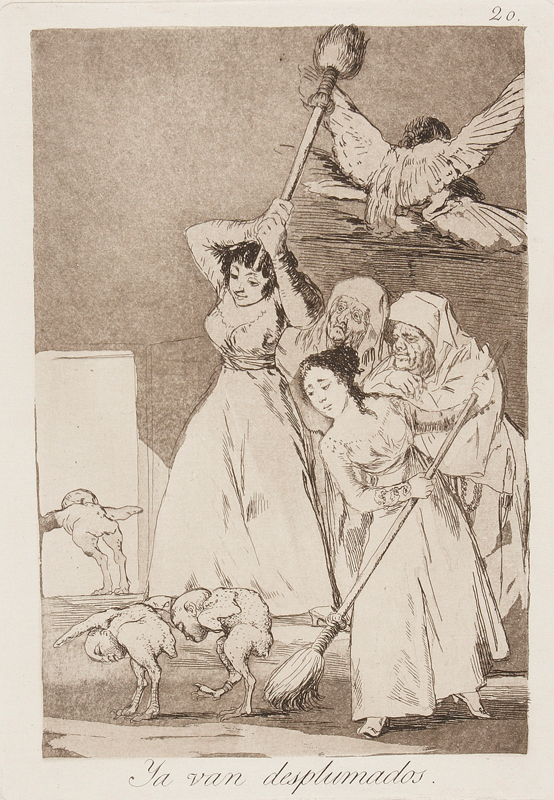Unflinching Vision: Goya’s Rare Prints
From royal portraiture to scenes in a bullring, Spanish artist Francisco de Goya y Lucientes infused his keen vision of the observed world with his own creative impulses. This delicate dance is visible throughout Goya’s incredible output of prints. While the majority were published posthumously, Unflinching Vision: Goya’s Rare Prints presents a selection of works that Goya himself worked on during his lifetime. More than 30 working proofs, trial proofs and published prints made under his supervision are on view, as well as a small selection of posthumous examples from his later numbered editions. Together, these artworks demonstrate Goya’s mastery of printmaking, and most significantly, his care in meaningfully capturing the spirit of his time.
Goya began to experiment with printmaking well after he had established himself as a successful painter to the royal court in Madrid. He started, tentatively, etching a few religious subjects, yet rather quickly he began his first ambitious series of etchings: 11 copies after masterpieces by the father of Spanish painting, Diego Velázquez. Goya’s skill as a draftsman is pronounced in these prints, as is his facility with working on a copper plate, for it is in this series that he first experiments with aquatint, a technique that allows the artist to create subtle tonal areas in the image rather than just scratched lines. “Un Infante de España,” on view in this exhibition,not only presents the formality of Velázquez’s composition but also exhibits Goya’s growing skill with intaglio techniques. Though aquatint is used here primarily in the background, Goya came to master its use, harnessing its subtlety to create depth and even to draw entire compositions.
By the mid-1790s Goya began to work on Los Caprichos, the first of four major print series that came to define his career as a printmaker. Images of people, witches and imagined creatures identifying specific social and cultural problems, with titles carefully narrating the scenes, make up this series. An early working proof of plate 6, “Nobody Knows Himself,” presents Goya’s concerns with deception and artifice, and it shows the print before numbering and with the title handwritten in ink. In plate 20, “There They Go Plucked (i.e. Fleeced),” prostitutes sweep out their customers, cowering and pathetic, as the women prepare for the next group of clients who hover above. The drama of the scene is enhanced by the contrast between completely uninked areas and the various gradations of aquatint that define recessional space, but as the edition was printed, this contrast was lost as the aquatint faded nearly completely. Exhibiting the working proof alongside the first, second and eighth editions of the same plate highlights this degradation. In the subsequent plates in the series, Goya deals with the hypocrisy of men who judge these women. The artist was not solely interested in recording scenes; rather, he drew on contemporary details and behavior for the purpose of arriving at a judgment.
While Los Caprichos describes a time before the turn of the century, when the French monarchy fell and Napoleon rose to power, Goya’s next series tells of the grueling six-year war between France and Spain that began in 1808. In addition to its cruel, disorganized and prolonged combat (the term “guerilla” warfare was coined from this war), it caused a disastrous famine. Many of its battles and events, including torture and starvation, are described brutally in the 82 plates of Goya’s print series The Disasters of War. “One Can’t Look,” plate 26,is a triumph of Goya’s compositional acumen. Men and women cower, plead and surrender in desperation within a web of dramatic shadows, and only the tips of the executioners’ bayonets reveal the reason for their suffering.
Perhaps due to the sensitivity of the subject, Goya decided not to publish an edition of The Disasters during his lifetime. Turning instead to a public project that was more benign, Goya prepared a series of bullfighting scenes, equally brilliantly executed and known ultimately as La Tauromaquia. This group of 33 prints traces the history of bullfighting in the country and can be read as being both respectful and critical of the pastime. In plate 20, the theatrical physical feats accomplished by a torero are on display. Yet, in the following plate, Goya reminds us of the deadly nature of the sport. His interest in the popular subject matter and its connection to his national identity was further illuminated when Goya was living in exile in Bordeaux, France. There, in 1825, he used lithography for the first concerted time in his life. The technique is very similar to drawing, and Goya was immediately able to create lively compositions with various (and predictable) passages of light and dark, in a series of four prints with the same theme, known as The Bulls of Bordeaux.
Whereas the two intaglio series—La Tauromaquia and The Disasters —depict real-life events, Goya continued to create wildly imaginative scenes that comment on contemporary behavior as in Los Caprichos. In the group of 18 prints gathered together and sold as Los Proverbios upon their first publication in 1864, Goya magnificently illustrates a number of human follies. Two-headed women, animals, giants and monsters are all situated in a world with no setting, no real context. The scenes are executed with brilliant technical facility: etched lines creating dynamic scenarios set off against the rich darkness of a field of aquatint, as in “A Way of Flying,” a fantastical illustration of the idea that “Where there’s a will, there’s a way.”
Unflinching Vision: Goya’s Rare Prints is presented in conjunction with The Frick Collection’s loan of Goya’s Don Pedro, Duque de Osuna, and in anticipation of the scholarly catalogue Goya in the Norton Simon Museum, to be published in 2014.

